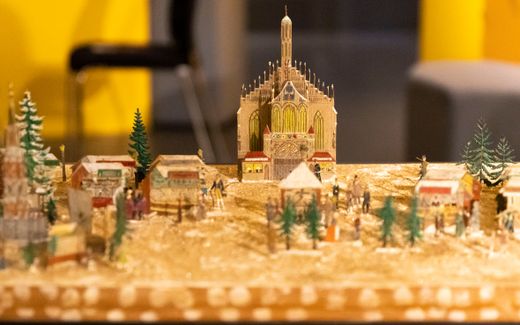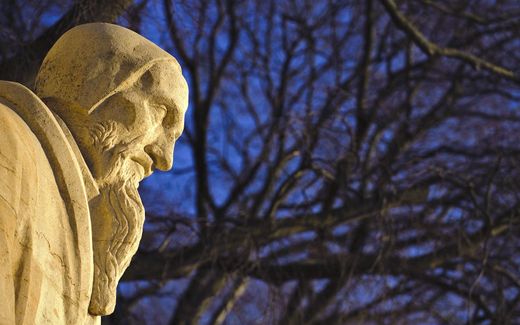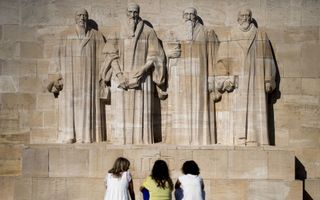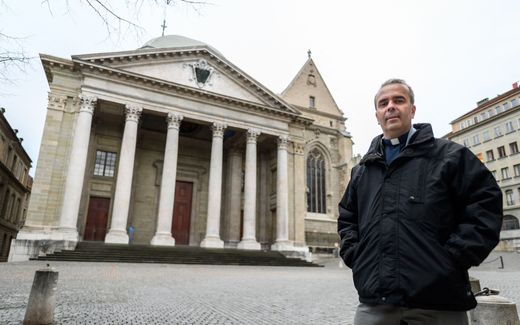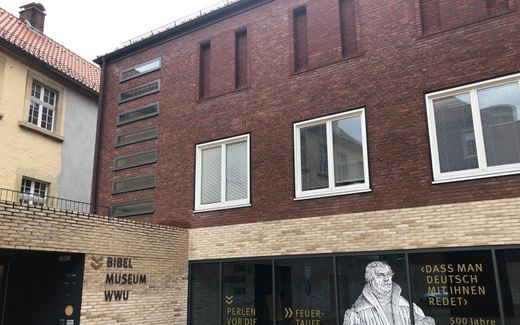Reformation Museum: Jeans are a specifically Protestant garment
09-05-2023
Central Europe
Laura Hendriksen-Bassa, RD
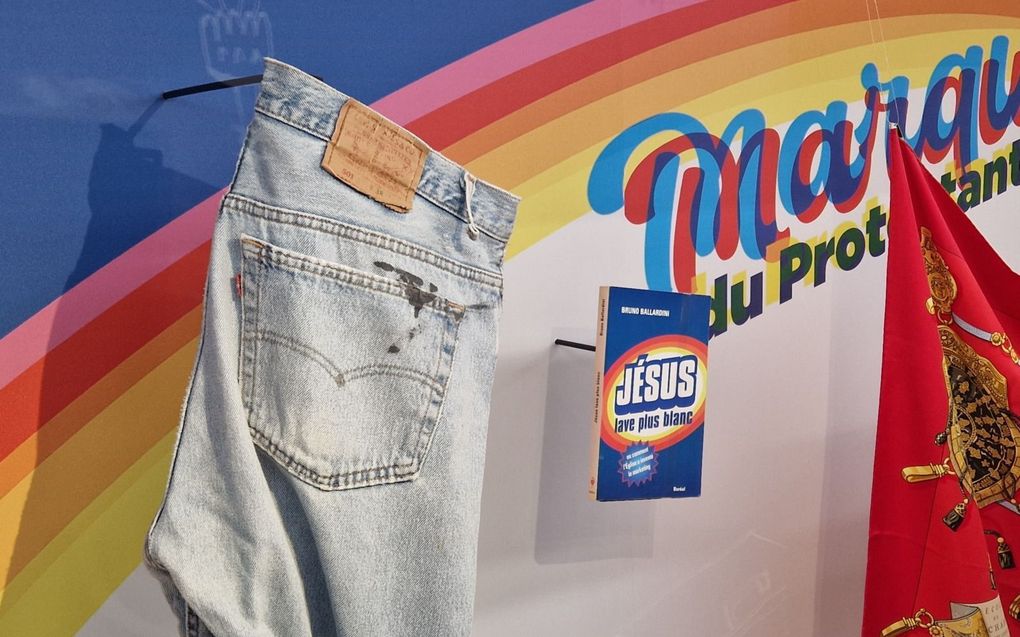
Jeans are a simple garment, typically Protestant, according to the Reformation Musuem in Geneva. Photo RD
Central Europe
"The Bible"," La Bible"," La Sacra Bibbia": There is no shortage of Bibles at the newly renovated Reformation Museum in Geneva. "Pour les réformateurs, la Bible est source de vie," explains a sign. "For the Reformers, the Bible is the source of life."
Buildings rise high on either side of Rue des Barrières. This narrow alleyway must be wonderfully cool in summer, but it is chilly in spring. Perhaps Calvin once walked here at the time when Geneva was the centre of the Reformation. In the city, however, little recalls this influential man of history. The reformer seems to have been forgotten.
The alley opens onto Rue de l'Evêché and then onto Cour de Saint-Pierre. The houses here give way to a spacious square. On benches, people eat their lunch. Some tourists walk up the steps of Saint-Pierre Cathedral. To the left of the church is the "Musée International de la Réforme".

You could visit the museum only through a virtual tour for almost two years. The building closed on 2 August 2021 for a significant renovation. Twenty-one months later, the museum has more space, the number of collections has increased, and the main entrance has been repositioned.
Luther's theses
Geneva may be the city of Calvin, but the Reformation Museum also gives attention to men like Luther, Zwingli, Melanchthon and Beza.
The museum consists of ten different rooms. Each one highlights an other aspect of the Reformation. A sign explains how the Reformation came about. Where the church was mainly after money, the reformers returned to the Scriptures.
Behind the glass hangs a Latin copy of the 95 Theses Luther nailed to Wittenberg's castle chapel in 1517. A sign explains how the Reformation affected daily life. Pastors replaced priests. Of the seven sacraments, five disappeared. A baptismal gown from the 19th century catches the eye. Also on display -as symbols of Reformed worship- are a wooden communion cup, a Bible, a sermon book and an hourglass. The latter object was used during the Reformation era to limit the preacher's speaking time. The authorities feared that political views would also be proclaimed in a long sermon.
Red, the colour of blood
The smell of paint still hangs in the newly renovated building. The floors creak. An elderly lady shuffles through the space. It is not crowded on the first day of the reopening. A man, about 60, shoots photographs.

In the second room, it is immediately noticeable that everything is red. That intense colour refers to the blood that flowed during the persecution of the French Calvinists - the Huguenots. A painting shows something of the terrible events of Bartholomew's Night. On the night of 23-24 August 1572, Roman Catholics massacred Huguenots in Paris. About 20,000 Protestants died. The French war between Roman Catholics and Protestants (1562-1598) eventually cost the lives of thousands of people on both the Roman Catholic and Protestant sides. Display cases contain pamphlets, satires and poems written during this war. Some 700,000 Huguenots fled France, 70,000 of whom ended up in Holland and 20,000 in Switzerland.
Monastery
The "Musée International de la Réforme" opened in Geneva in April 2005. The museum building was constructed in the 18th century. For years, it served as a monastery.
In the summer of 2021, the museum will close for an extensive renovation. The main entrance will be moved from Rue du Cloître to Cour de Saint-Pierre. The museum will have more space available in the building, allowing it to accommodate temporary exhibitions.
The museum will reopen to visitors on 27 April 2023. They can explore the exhibition via an audio guide, available in nine languages.
Before the renovation, the museum had around 25,000 visitors a year. Gabriel de Montmollin, director of the museum, expects around 30,000 to 35,000 visitors a year after the reopening.
The museum, which is located in Geneva's historic city centre, is best reached by public transport.
Room 6 shows how the Reformation spread around the world. A slide projects a ship on the wall. It is the Mayflower, the vessel on which, in September 1620, the first European settlers travelled to America to make a life free of religious persecution. With their crossing, their beliefs also spread.
A familiar melody sounds from the next room. It is Psalm 42, composed by Claude Goudimel. Born around 1500, this Frenchman was one of the most influential composers of the 16th century. He made arrangements for the 150 Geneva Psalms. He was probably murdered during St Bartholomew's Day.
Jewish
The rooms at the bottom of the museum show the influence of the Reformation over the past two centuries. Sometimes it is challenging to find the link between the objects on display and the Reformation. One display case shows a computer, a pair of jeans and the steering wheel of a car. "You could say that jeans are a Protestant garment - even though their maker is Jewish. It conforms to the clothing values of Protestantism: simple in form and sober in colour," a sign explains.
In the next room, hang pictures of influential Protestant figures of the 20th century. Søren Kierkegaard, Karl Barth, Friedrich Schleiermacher. Some names are more famous than others.
The last room shows actual images. A film clip of a boat overflowing with refugees, a climate demonstration, and the inauguration of Barack Obama. Here, too, it is sometimes hard to see the link with the Reformation.
Drawing
A temporary exhibition is running at the Reformation Museum: "Déflagrations" or "Explosions". One hundred and forty children's drawings hang on the wall. The young artists have committed their memories of the war to paper. Some of the drawings are almost a century old. In one of the illustrations, people meet their end in the gas chamber. The image next to it shows how a raid rages in a ghetto. A little further on hangs a drawing of a more recent date. This one was made during a summer camp in 2022 for children aged 6 to 12. The drawing shows the blue-and-yellow colours of the Ukrainian flag, but in addition, there is also a section painted red and black. What memories will this young artist have had when making this painting?
Once back in the square in front of the Saint-Pierre, the old cathedral strikes twelve beats. Calvin brought the Word here. "Chaque fidèle doit y avoir accès dans sa propre langue," the Reformers believed. Every believer should have a Bible in his own language at his disposal. Those who walk out of the museum realise: we owe a lot to the Reformation.
This article was translated by CNE.news and published by the Dutch daily Reformatorisch Dagblad on May 5, 2023
Related Articles

